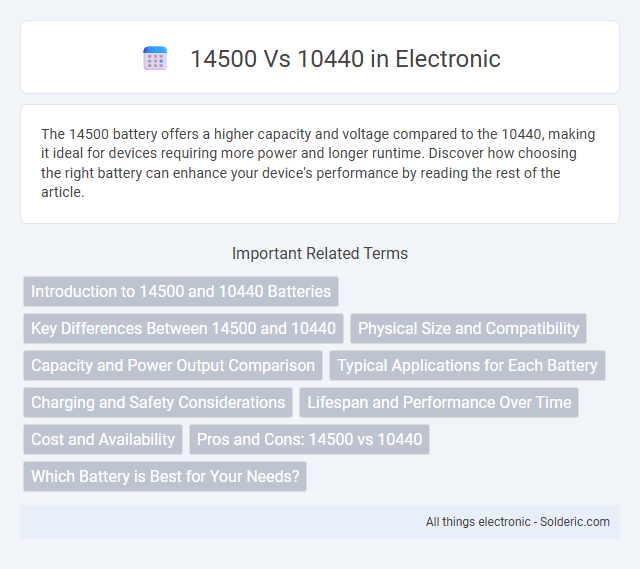The 14500 battery offers a higher capacity and voltage compared to the 10440, making it ideal for devices requiring more power and longer runtime. Discover how choosing the right battery can enhance your device's performance by reading the rest of the article.
Comparison Table
| Feature | 14500 Battery | 10440 Battery |
|---|---|---|
| Size (mm) | 14 x 50 | 10 x 44 |
| Voltage | 3.7V (Li-ion) | 3.7V (Li-ion) |
| Capacity (mAh) | 600 - 1000 mAh | 320 - 350 mAh |
| Typical Use | Flashlights, cameras, portable electronics | Small electronics, LED lights |
| Rechargeable | Yes | Yes |
| Weight (g) | Approx. 18-20 | Approx. 9-11 |
| Compatibility | Devices supporting AA size Li-ion batteries | Devices requiring AAA size Li-ion batteries |
Introduction to 14500 and 10440 Batteries
14500 and 10440 batteries are compact lithium-ion cells commonly used in high-drain devices requiring reliable power sources. The 14500 battery typically measures 14mm in diameter and 50mm in length, while the 10440 is smaller, with dimensions of 10mm diameter and 44mm length, both sharing a nominal voltage of 3.7 volts. These batteries differ primarily in size and capacity, with the 14500 offering higher energy storage suitable for flashlights, vaping devices, and portable electronics, whereas the 10440 is favored for compact devices and certain medical equipment.
Key Differences Between 14500 and 10440
The key differences between 14500 and 10440 batteries lie in their size, voltage, and capacity. The 14500 battery measures 14mm in diameter and 50mm in length, with a nominal voltage of 3.7V and a higher capacity typically around 800-1100mAh, making it suitable for devices needing longer runtimes. The 10440 battery is smaller at 10mm diameter and 44mm length, also offering 3.7V but with a lower capacity around 300-350mAh, ideal for compact devices where space is limited. Your choice depends on the device compatibility and desired usage duration.
Physical Size and Compatibility
The 14500 battery typically measures 14mm in diameter and 50mm in length, resembling the size of a standard AA battery, while the 10440 battery is smaller, with dimensions around 10mm in diameter and 44mm in length. This size difference directly affects compatibility, as devices designed for AA batteries often fit the 14500 but not the more compact 10440. When choosing between the two, ensure your device supports the physical size of the battery to avoid improper fit or performance issues.
Capacity and Power Output Comparison
The 14500 battery typically offers a higher capacity, averaging around 800-1,100mAh, compared to the 10440's lower capacity of about 300-350mAh, resulting in longer usage times. In terms of power output, both batteries usually provide a nominal voltage of 3.7V, but the 14500 can sustain higher current draws, making it suitable for devices requiring more power. Your choice between the two should depend on whether you prioritize longer battery life or compact size for specific power needs.
Typical Applications for Each Battery
14500 batteries, resembling AA size, are typically used in high-drain devices such as flashlights, digital cameras, and portable electronics where long-lasting power and higher capacity are essential. The smaller 10440 batteries, similar to AAA size, are ideal for compact devices like laser pointers, medical instruments, and small LED flashlights that require lightweight power sources but lower capacity. Choosing the right battery for your device ensures optimal performance and longevity based on your application's power demands.
Charging and Safety Considerations
When comparing 14500 and 10440 batteries, 14500 cells generally offer higher capacity and voltage, making them suitable for devices requiring longer runtimes but needing compatible charging equipment designed for their 3.7V output. Charging safety is critical as 10440 batteries operate at 3.7V as well but often have lower capacity, and improper charging can lead to overheating or potential hazards due to their smaller size and limited thermal dissipation. Your charger must match the battery chemistry and size to ensure safe charging cycles and prevent damage or safety risks.
Lifespan and Performance Over Time
The 14500 battery typically offers a longer lifespan with more charge cycles compared to the 10440, making it more durable for frequent use. Performance over time in the 14500 remains relatively stable due to its higher capacity and better thermal management. In contrast, the 10440 tends to degrade faster, showing reduced capacity and voltage stability after fewer charge cycles.
Cost and Availability
The 14500 batteries generally cost more than 10440 batteries due to their higher capacity and widespread applications in high-drain devices, but they offer better value for devices requiring longer runtimes. Availability of 14500 batteries is broader globally, found in most electronics stores and online marketplaces, whereas 10440 batteries, being smaller and less common, can be harder to source and often limited to niche retailers specializing in compact rechargeable cells. When balancing cost and accessibility, 14500 batteries provide a more readily available and affordable option for everyday use compared to the less commonly stocked 10440 batteries.
Pros and Cons: 14500 vs 10440
14500 batteries offer higher voltage (3.7V) and capacity, making them ideal for power-hungry devices and longer run times, whereas 10440 batteries provide a lower voltage (3.7V or 3.2V) but more compact size suitable for small electronics. You should consider 14500 batteries for applications requiring more energy and 10440 for portable devices with tight space constraints. Cons of 14500 include larger size and higher cost, while 10440 batteries typically have shorter runtimes and lower capacity.
Which Battery is Best for Your Needs?
The 14500 battery offers higher capacity and voltage, typically 3.7V with around 800-1000mAh, making it ideal for devices requiring longer runtime and more power, such as high-drain electronics. The 10440 battery, smaller in size and similar in voltage, usually provides around 350mAh, making it better suited for compact devices with low power consumption. Choosing the best battery for your needs depends on the device size and power requirements, where the 14500 suits more demanding applications and the 10440 fits smaller gadgets.
14500 vs 10440 Infographic

 solderic.com
solderic.com